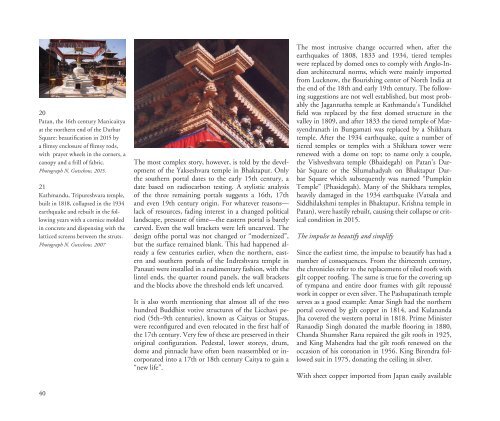KVPT’s Patan Darbar Earthquake Response Campaign - Work to Date - September 2016
Create successful ePaper yourself
Turn your PDF publications into a flip-book with our unique Google optimized e-Paper software.
20<br />
<strong>Patan</strong>, the 16th century Manicaitya<br />
at the northern end of the <strong>Darbar</strong><br />
Square: beautification in 2015 by<br />
a flimsy enclosure of flimsy rods,<br />
with prayer wheels in the corners, a<br />
canopy and a frill of fabric.<br />
Pho<strong>to</strong>graph N. Gutschow, 2015.<br />
21<br />
Kathmandu, Tripureshvara temple,<br />
built in 1818, collapsed in the 1934<br />
earthquake and rebuilt in the following<br />
years with a cornice molded<br />
in concrete and dispensing with the<br />
latticed screens between the struts.<br />
Pho<strong>to</strong>graph N. Gutschow, 2007<br />
The most complex s<strong>to</strong>ry, however, is <strong>to</strong>ld by the development<br />
of the Yakseshvara temple in Bhaktapur. Only<br />
the southern portal dates <strong>to</strong> the early 15th century, a<br />
date based on radiocarbon testing. A stylistic analysis<br />
of the three remaining portals suggests a 16th, 17th<br />
and even 19th century origin. For whatever reasons—<br />
lack of resources, fading interest in a changed political<br />
landscape, pressure of time—the eastern portal is barely<br />
carved. Even the wall brackets were left uncarved. The<br />
design ofthe portal was not changed or “modernized”,<br />
but the surface remained blank. This had happened already<br />
a few centuries earlier, when the northern, eastern<br />
and southern portals of the Indreshvara temple in<br />
Panauti were installed in a rudimentary fashion, with the<br />
lintel ends, the quarter round panels, the wall brackets<br />
and the blocks above the threshold ends left uncarved.<br />
It is also worth mentioning that almost all of the two<br />
hundred Buddhist votive structures of the Licchavi period<br />
(5th–9th centuries), known as Caityas or Stupas,<br />
were reconfigured and even relocated in the first half of<br />
the 17th century. Very few of these are preserved in their<br />
original configuration. Pedestal, lower s<strong>to</strong>reys, drum,<br />
dome and pinnacle have often been reassembled or incorporated<br />
in<strong>to</strong> a 17th or 18th century Caitya <strong>to</strong> gain a<br />
“new life”.<br />
The most intrusive change occurred when, after the<br />
earthquakes of 1808, 1833 and 1934, tiered temples<br />
were replaced by domed ones <strong>to</strong> comply with Anglo-Indian<br />
architectural norms, which were mainly imported<br />
from Lucknow, the flourishing center of North India at<br />
the end of the 18th and early 19th century. The following<br />
suggestions are not well established, but most probably<br />
the Jagannatha temple at Kathmandu’s Tundikhel<br />
field was replaced by the first domed structure in the<br />
valley in 1809, and after 1833 the tiered temple of Matsyendranath<br />
in Bungamati was replaced by a Shikhara<br />
temple. After the 1934 earthquake, quite a number of<br />
tiered temples or temples with a Shikhara <strong>to</strong>wer were<br />
renewed with a dome on <strong>to</strong>p; <strong>to</strong> name only a couple,<br />
the Vishveshvara temple (Bhaidegah) on <strong>Patan</strong>’s Darbār<br />
Square or the Silumahadyah on Bhaktapur <strong>Darbar</strong><br />
Square which subsequently was named “Pumpkin<br />
Temple” (Phasidegah). Many of the Shikhara temples,<br />
heavily damaged in the 1934 earthquake (Vatsala and<br />
Siddhilakshmi temples in Bhaktapur, Krishna temple in<br />
<strong>Patan</strong>), were hastily rebuilt, causing their collapse or critical<br />
condition in 2015.<br />
The impulse <strong>to</strong> beautify and simplify<br />
Since the earliest time, the impulse <strong>to</strong> beautify has had a<br />
number of consequences. From the thirteenth century,<br />
the chronicles refer <strong>to</strong> the replacement of tiled roofs with<br />
gilt copper roofing. The same is true for the covering up<br />
of tympana and entire door frames with gilt repoussé<br />
work in copper or even silver. The Pashupatinath temple<br />
serves as a good example: Amar Singh had the northern<br />
portal covered by gilt copper in 1814, and Kulananda<br />
Jha covered the western portal in 1818. Prime Minister<br />
Ranaodip Singh donated the marble flooring in 1880,<br />
Chanda Shumsher Rana repaired the gilt roofs in 1925,<br />
and King Mahendra had the gilt roofs renewed on the<br />
occasion of his coronation in 1956. King Birendra followed<br />
suit in 1975, donating the ceiling in silver.<br />
With sheet copper imported from Japan easily available<br />
40




